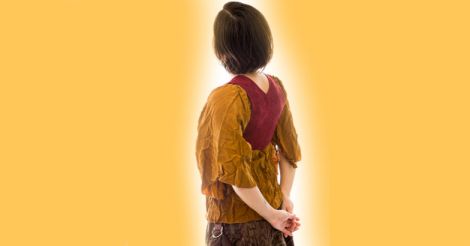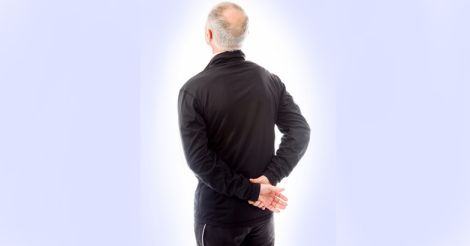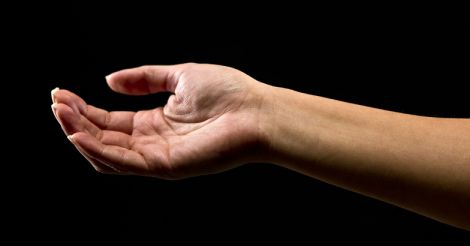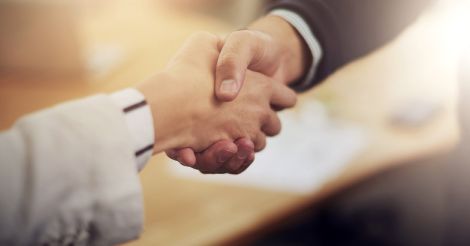They built the Taj Mahal and chiselled The Thinker, they painted the Sistine ceiling and planted the American flag on the moon; they enable the visually-impaired to read the classics and, later this year, they will attempt the world’s first human head transplant. They can pluck the strings of a sitar, pinch the bridge of your nose, forge steel, write poetry and point to butterflies on the wing. They can grip and grasp, scribble and scratch, punch and poke, fondle and feel, hold and mould.
Also read: Heal Thy Self | When your mind goes A W O L
No other “tools” have been more important in human evolution. And, among all species, our human hands are unique. There are more nerve connections between our hands and our brain than any other part of our body. That makes our hands capable of the most expressiveness. When it comes to speaking in body language, hands have more to say than even faces.
Also check: Heal Thy Self | Shaken, not seared
So connected are our hands to our nervous system that we rarely keep them still. When a hand is not moving or handling an object, it is busy scratching, holding, or massaging its own partner. This peculiar tendency of the digits to fuss and fidget intensified over the aeons as our fingers became major tools to explore and shape our material world. The more gifted they became, the more we waved them about as sensory feelers. And yet, if you asked most people, they would be hard pressed to tell you all the things that hands reveal.
Some hand gestures are, of course, easy enough to read: balling the fists (anger); hands on hips (readiness to act; dominance); hands clenched together (frustration/ restraint/ anxiety). But, with a total of 100 bones, muscles, joints and nerves, our hands are crafted to shape literally thousands of signs. To describe all the language that hands are capable of would take at least one book. So, here are just a few tantalizing glimpses into what some of those hand cues and gestures mean.
Steepled fingers
 Photo: Getty Images
Photo: Getty ImagesSignify » 1. Thinking / Evaluating
2. Confidence
In this gesture, the fingertips of one hand gently touch their counterparts on the other hand, creating the shape of the rafters of a tall church roof, or steeple.
The steeple cue operates at two different levels in body language. At one level, it reflects precise thought patterns. It may be used while listening, speaking or thinking, to entertain a provocative or novel idea, or to contemplate a creative solution to a problem at hand.
Why does steepling signify precise thinking and careful calculation? Neurologists explain that steepling has its origins in brain modules of the“precision grip”, a position of the hands perhaps first used 2.6 million years ago, when our ancestors opposed their digits to make stone tools. Controlled in part by highly evolved areas of our “newer brain” (the neo-cortex), these dexterous brain modules for tool-making gradually shifted into gear for problem-solving, planning and design. That’s how steepling today reflects higher-order thought processes.
But thesteeple also signifies being in control and, used carefully, it can establish you as someone who is both, evaluative and in control. The steeple is called the ‘power position’ because it’s often used in superior-subordinate interactions when instructions or advice are being handed out; it is particularly common among managers, accountants and lawyers. The risk here is that “confidence” can sometimes so easily slip into and signify a know-it-all smugness, even arrogance. The risk of such an interpretation increases if the steepler also tilts his head back (or just leans back in his boardroom chair) as he steeples his fingers.
The steeple has two versions: the Raised steeple, an upward-pointing version, often assumed when the steepler is giving his opinions or ideas, or is doing the talking; the steepled hands are held in front of his face or chest. The Lowered steeple is normally used when the steepler is listening rather than speaking (with the “steeple” resting on the table or in front of the lower abdomen, e.g., on the person’s lap or knee). The Raised position tends to form a distancing or defensive barrier against the other person; when you want to connect more, to look interested and ready to respond, you’ll tend to hold the steeple lower. Women use the Lowered steeple position more often than men do.
World leaders, including Winston Churchill, George W. Bush, Angela Merkel and Vladimir Putin, all used (or use) the steeple gesture to signal self-confidence. It is certainly Trump’s classic trademark gesture of superiority, screaming out the message, “I am the boss here. I am the one calling the shots.” It has been one of his favourite body-language signals since his hiring-and-firing days on The Apprentice, signifying, of course, the absolute power he wielded on the reality show.
Hands held behind back
 Photo: Getty Images
Photo: Getty ImagesSignify » Confidence; Fearlessness
The Duke of Edinburgh and several other male members of the British Royal Family are noted for their habit of walking with head up, chin out and hands behind the back, one palm within the other palm. This gesture is common among leaders and royalty, and is used by cops or soldiers as they stand or pace, keeping the peace, by the principal on an inspection around the school playground, by teachers walking between desks as they supervise an exam.
The posture expresses superiority, confidence and power. The person exposes his vulnerable stomach, heart, genital area and throat in a sub-conscious act of fearlessness. In animal terms, you are exposing yourself to potential attack. It’s as if you’re saying, “I’m so powerful, no one would dare to do anything to me, so I need not protect my front!”
The fact that this position improves posture also enhances feelings of energy and confidence. There is some research showing that if you take this position when you are in a high-stress situation, such as being interviewed by a media reporter, you’ll begin to feel confident and even authoritative, as a result of cause and effect (erect body posture bringing on a feeling of power).
Arms behind back, hand gripping opposite wrist
 Photo: Getty Images
Photo: Getty ImagesSignifies » Frustration; self-control
hands held behind the back, palm within palm are (as mentioned above) a sign of self-assurance and confidence. But hands held behind the back, not with the palms one over the other, but with one palm gripping the opposite wrist or arm, is a different matter altogether – it signals frustration and an attempt at self-control. It’s as if one hand is literally trying to hold back the other one, to prevent it from striking out.
When one hand is gripping the opposite arm at a level higher than the wrist, it suggests a greater effort at self-control: the higher up one hand grips the opposite arm, the more frustrated or angry the person is likely to be. This gesture is most probably the origin of the expression, ‘Get a good grip on yourself.’
Wrist-and-arm-gripping behind the back can often be observed outside a courtroom when warring parties are face to face, or in patients pacing the floor as they wait for a doctor who’s late coming in. It’s an attempt to disguise nervousness or self-restraint and, if you catch yourself doing it, change to the palm-in-palm behind the back and you will begin to feel more in control.
The Palm-up gesture
 Photo: Getty Images
Photo: Getty ImagesSignifies » 1. Openness
2. Submission
In ancient times, open palms were used to show that no weapons were being concealed. Today, the palm(s) facing up is still commonly used as a gesture with various meanings around a main theme of openness.
The upraised palm is a frequent accompaniment to an apology or an alibi. As you try blaming the computer for eating your homework, you shrug your shoulders and expose your palms as a show of helplessness. What could I do?
The palm-up gesture is also used as a submissive, non-threatening gesture – whether it’s the pleading, one-upturned-palm of beggars, or the two-palm version favoured by preachers reaching out to beseech divine assistance.
Throughout history, the open palm has been associated with honesty, allegiance and submission. Many oaths are still taken with the palm of the hand over the heart, some (as in a court of law) by raising a single palm in the air. (But watch it with the open-palm gesture – it’s one that’s easily faked to convey innocence by someone who manipulatively wishes to do so. Con artists, inveterate liars and second-hand car dealers know the significance of the open-palm gesture and use it to convince their victims that they are being upfront and sincere. But you’ll be able to detect that something is not quite right because other body cues will be shouting it out – e.g., open facial expressions and / or a relaxed stance or calm breathing will be conspicuous by their absence!)
When children are lying or concealing something, they’ll often hide their palms behind their backs. Similarly, a man who wants to conceal his whereabouts after a night out at the pub, might hide his palms in his pockets as he tries to explain to his wife that he was working late. However, the hidden palms could signal to her that he is not telling the truth. Palms are like the vocal cords of body language because they do more ‘talking’ than any other body part, and putting them away is like keeping one’s mouth shut.
The fig leaf and the body hug
 Photo: Getty Images
Photo: Getty ImagesSignify » Insecurity; Vulnerability
The ‘fig leaf’ is a typical male posture in which a man holds his hands clasped in front of his body. It is a barrier position, aimed at making him feel secure in a situation where he’s nervous, defensive or lacking in self-assurance – e.g. when he’s waiting to speak before a big or hostile crowd. The origin of this gesture is, of course, the primal male instinct to avoid a potential full frontal attack; by adopting the ‘fig leaf’ pose, he’s sub-consciously covering his “crown jewels”.
Hitler regularly adopted this pose (or, at least, had one arm protecting himself up front). Easily explained, apparently: he had only one testicle, and this was an unconscious attempt to mask, in public, the sexual inadequacy that he chronically felt.
The predominantly female equivalent of the ‘fig leaf’ is the ‘body hug’. Either crossing both arms across the body, or one arm crossing the body and holding or touching the other arm. Both are defensive postures, but the half-hug is (as its name signifies), in the nature of a half-barrier. Variants of the body hug are: stroking your arms, rubbing your neck or fondling your face. These are the kind of stroking or holding gestures that your parents or other care-givers would use to comfort you as a child. Now, as an adult, when you feel insecure and there happens to be no one around to reassure you (or if hugging or stroking would be inappropriate from those present), you hug or stroke yourself as you seek to provide your own solace and reassurance.
Hand behind head
Signifies» Resistance; Embarrassment; Frustration
 Photo: Getty Images
Photo: Getty ImagesThe hand-behind-head gesture is mainly displayed by touching, scratching or holding the back of the neck or the head with the open palm. There are variants: one is reaching a hand upward to scratch your ear, grasp a earlobe, or stimulate a ear canal; another is touching, scratching or rubbing your cheek or the side of your neck.
All these are hand gestures that typically reflect negative thoughts, feelings and moods. And they cover a wide range of such reactions. In a conversation, hand-behind-head may be read as a potential sign of uncertainty, conflict, disagreement, embarrassment, frustration, anger or dislike. In a counselling situation, as also in interviewing or cross-examining, the gesture telegraphs a “probing point” i.e., an unresolved issue that needs to be verbalized and explored. Sometimes, in psychiatric settings, clients use hand-behind-head cues when disagreeing with the doctor.
Situations – or even issues, e.g., homosexuality – which cause a person to feel embarrassment may bring on the hand-behind-head gesture.
Examples of this gesture in the daily work routine:
A co-worker is asked whether he’d like to join the group for lunch. Hesitantly, he touches the back of his head with his hand. Sensing uncertainty, a colleague says, “Maybe tomorrow, then?”
At the weekly staff meeting, you suggest a new idea. A team member glances away and clasps his neck. Sensing resistance (which could fester and sabotage the proposal), you ask him to voice his opinion to the group.
hand-behind-head is not a learned gesture; it is part of our evolutionary inheritance. Children as young as two years may respond to being scolded by a parent with the hand-behind-head gesture combined with gaze avoidance. Even deaf-and-blind-born children will scratch the back of their neck in a frustrating, puzzling or conflict-arousing situation.
Hand-behind-head is a gestural fossil left over from spinal-cord circuits designed to keep the body upright in relation to gravity through neck reflexes. In other words, it’s a body-protective gesture.
Importantly, hand-behind-head is a gesture made with one hand only. Leaning back and placing both hands behind the neck – the so-called “head clamp” posture – is a non-verbal sign of dominance.
Handshakes
 Photo: Getty Images
Photo: Getty ImagesSignify » 1. Dominance
2. Submission
3. Power Struggle
4. Equality
The handshake is not a standard greeting in India the way it has been for centuries in the Western world. But it is increasingly in vogue, especially in corporate circles and on the high-roller social circuit.
Shaking hands is a relic of our ancient past. Whenever primitive tribes met under friendly conditions, they would hold their arms out with their palms exposed to show that no weapons were being concealed. In Roman times, the practice of carrying a concealed dagger in the sleeve was common, so for mutual protection the Romans developed the Lower Arm-Grasp as an accepted form of greeting.
The modern form of this ancient greeting ritual is the interlocking and shaking of the palms, and it was originally used in the 19th century to seal commercial transactions between men of equal status. It became widespread only in the last hundred years or so and remained in the male domain until recent times.
On the whole, in India, as in a number of other countries, shaking hands with a woman is still an uncertain practice. That said, research has found that women who introduce themselves with an assertive gesture by way of a firm handshake are perceived as being intellectual and open to new experiences”, and that they make better first impressions.
Few people stop to consider how they shake hands when they meet someone. Yet those initial pumps establish whether dominance, submission or a power struggle will take place. Let’s assume that you’ve just met someone for the first time and you greet each other with a handshake. One of three basic attitudes is sub-consciously transmitted:
Dominance: The Palm-down handshake (turning your hand so that your palm faces down in the handshake) is the one that communicates power and control. It gives you the upper hand, literally, and communicates that you want to take control of the encounter.
Submission: The opposite of the dominant handshake is to offer your hand with your palm facing upwards, symbolically giving the other person the upper hand, like a dog exposing its throat to a superior dog.
Equality: When two equally confident (and equally courteous) persons shake hands, both hands are offered in the vertical position and this creates a feeling of equality and mutual respect. Another ingredient for creating rapport in a handshake is to apply moderate pressure, eschewing both, the bone-crusher as well as the ‘dead-fish’ handshake.
How to disarm a power player
 Photo: Getty Images
Photo: Getty ImagesIf you feel someone is deliberately bearing down on you with a palm-down thrust, there are several counters to it. Here’s one:
The hand-on-top technique. Also called the double-hander. When a power player presents you with a Palm-Down Thrust, respond with your hand in the Palm-Up position, then put your left hand over his right to form a Double-hander and straighten the handshake. This switches the power from him to you. But it can shock a power player, so you need to be selective about it and use it only as a last resort.
(The author is a former editor of 'Health & Nutrition' magazine, and now works as a counseling therapist)


























 Photo: Getty Images
Photo: Getty Images